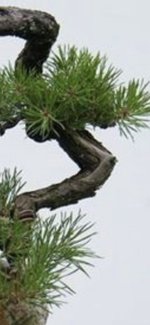Convincing shari and wild-looking bends are achievable on pines and do not necessarily require a wild collected tree.
For bends, the catch is that one needs to be realistic about what they can hope to achieve based on the maturity of the trunk/branch and skillset. For beginners, landscape nursery stock pines are the easiest thing to obtain, but as input material probably generate the most head scratching and questions like "
how does anyone achieve that? Do I really need raffia, rebar and 2 other strongarms to help push? How does anyone achieve any of this at all starting with material like this?".
The (hopefully not too deflating) answer is that we don't. We're (usually) not trying to put either subtle/beautiful nor extreme bends into already-thickened, already-established, unrecoverably-boring pine trunks. We're selling or giving that material away in favor of material that can support these goals. You have to intervene before the window of opportunity closes and (when looking for material) recognize where the potential for future intervention still exists.
Fancy bends are wired into younger pine material and then that material is developed from there, eventually turning into trees like the above. For an example of some really sweet bends that will almost never (if ever) occur naturally in young material (even wild seedlings) or in landscape nursery stock, look at the way
Jonas wired these pines. But also notice that this was done when it was still completely possible and easy to do.
With pine shari it's a similar story, the earlier you intervene the better, because adding information to that shari every season or three and having the shari evolve year-by-year with the tree can yield some really nice and convincing results that aren't as easily accomplished if you're buying an established pine and trying to put all that in after the fact.
So if you like this sort of stuff a lot, it's good to build up a collection of very young pine material and get very good at early-stage wiring. In SoCal you have the potential to develop seedlings quite quickly, and to witness some pretty rapid shari evolution.




